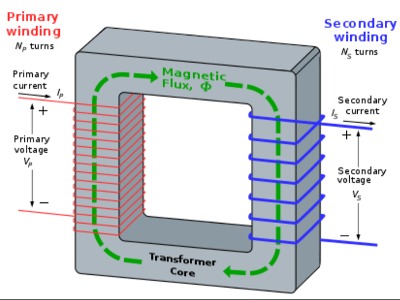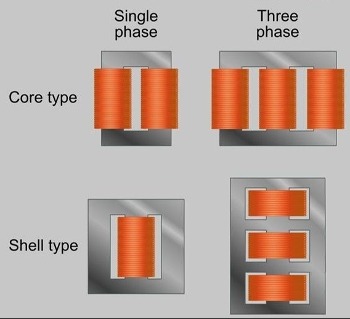
An electrical transformer is a machine that transfers electrical energy from one circuit to another via electromagnetic induction without changing the frequency.
It is a vital device in power transmission that links the generating stations and the users.
A transformer comprises a pair of coils, wound around a laminated magnetic core.
The winding that supplies alternating current (AC) to the transformer is the primary winding or coil while the output coil is the secondary winding.
A transformer can either be a step up or a step-down. A step-up transformer converts a low voltage, and high AC current into a high voltage, and low current.
While the step-down transformer converts high AC voltage and low current, to a low voltage and high AC current.
Construction of an electrical transformer.
For someone that wishes to build an electric transformer, a basic knowledge of its construction is important.
The transformer comprises two separate coils, the primary and secondary coils wound around a laminated steel core.
The primary coil supplies currents to the system, while the secondary coil is the output windings.
A transformer may also have a tank, bushings for letting out the terminals, and an oil conservator.
Constructing the magnetic core requires a close stacking of laminated sheets of steel in a container, to ensure continuity of the magnetic flux within the core.
The lamination prevents loss of energy because of eddy currents induced in the core.
How do electrical transformers work?
The working principle of a transformer is simple: it follows the faraday law of electromagnetic induction.
Michael Faraday in 1831 discovered that we can generate currents by moving either a conductor or a magnet around each other.
The law states that the strength of the E.M.F., or currents induced in a conductor when it moves through a magnetic field, is directly proportional to the rate at which the conductor moves.
He also discovered that when two coils are close to each other, a current flowing in one coil can induce a current in the other coil. This is called mutual inductance, and that’s how transformers work.
So if we apply an alternating current on the primary coil of a transformer, it creates an alternating flux in the core to link the secondary coil. Thus, inducing an E.M.F. of the same frequency to the secondary coil.
Although transformers are built to reduce flux leakage, the inductance is never 100% efficient.
Note: Transformers do not work on direct currents (DC) because they are direct and steady (no relative motion).
Types of transformers
Electrical transformers can be classified into various types depending on their construction, purpose, cooling method, and supply.
Construction type
Based on construction, we have two types of transformers, the core, and the shell-type.

The core type has its windings at the two core limbs, it also has one magnetic flux path, a better cooling surface, and many other features.
The shell-type transformer has its winding at the mid-arm of the core. It also has two magnetic flux paths, a less effective cooling surface, and other features.
Based on the purpose
- Step-up transformer: This transforms a low voltage, high current AC to a high voltage, and low current AC. They also have a higher number of turns in the secondary winding than the primary.
- Step-down transformer: Converts high voltage, low current to low voltage, and high current. It also has a greater number of turns in the primary windings than the secondary windings.
Based on the cooling method.
- Air-cooled transformers: This transformer has a fan that cools the engine during operation.
- Oil-filled self-cooled transformers: This is usually a small transformer of about 3 MVA, and they cool themselves by the surrounding airflow.
- Water-cooled oil-filled transformers: this transformer uses a heat exchanger to transfer heat from the oil to the cooling water.
Based on supply
- Single-Phase Transformer: A single-phase transformer has one set of windings.
- Three-Phase Transformer: These types of transformers have 3 sets of primary and secondary coils, and are mainly used for the generation, transmission, and distribution of power in industries.
Based on use
- Power transformer: used to transmit power and have a high rating.
- Distribution transformer: used to distribute electricity, it has a lower rating.
- Instrument transformer: This transformer is further sub-divided into current and potential transformers.
Characteristics of Power Transformers
Although we have different transformers, they still share common features. Below are the characteristics of an electrical transformer.
- They transfer electricity from one circuit to another, but their frequency remains the same.
- All transformers work according to Faraday’s law of electromagnetic induction.
- A transformer doesn’t need a moving part to transfer energy. So losing energy via friction is minimal.
- There is no electrical connection between the primary and secondary winding. The transfer of currents is via magnetic flux.
- The loss of currents that occur in transformers is smaller compared to other electrical devices, and they include:
1. Copper loss: This is a power loss that occurs as the current circulates around copper windings. It is considered the heaviest loss in an electric transformer.
2. Core loss: These are lost because of eddy current and hysteresis, resulting from lagging of magnetic molecules in response to the alternating magnetic flux within the core.
Most transformers are efficient, delivering about 96% energy at full load. High-capacity transformers may deliver up to 98%, especially when they operate at constant frequency and voltage.
Uses of transformers
The primary use of a transformer is to step up or down an electric voltage.
Other uses include
- To block the passage of direct current from one circuit to another.
- Impedance matching: To increase or decrease the value of a capacitor or an inductor in an AC circuit.
- Electrical isolation: To isolate two electrical circuits if the need arises.
- Transfer bulk power from generating stations to users.
- Used on mobile phone chargers to step down 220V alternating current to about 5 – 8V. The charger then converts the AC to DC current before use.
- Used on doorbells to step down household currents from 120 V to about 16-24 volts required by smart doorbells
Related articles